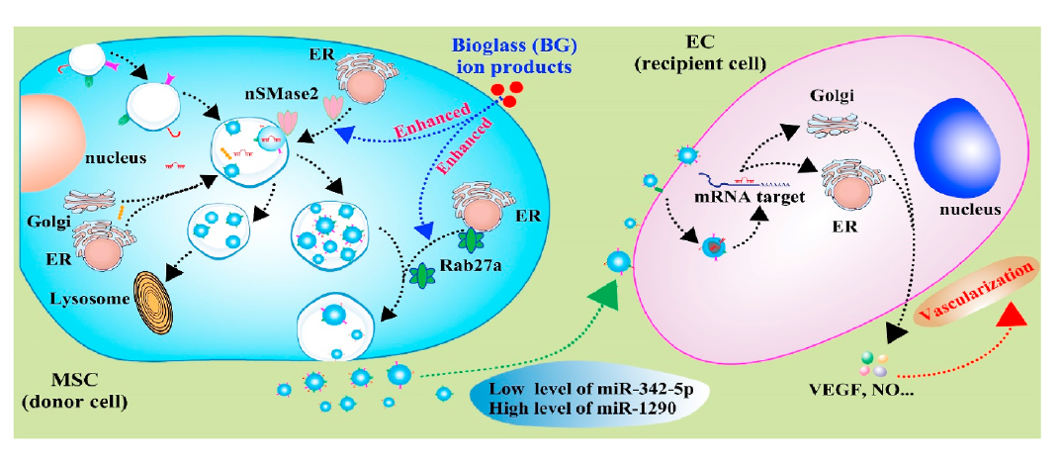
近年来,外泌体在组织再生中的应用越来越广泛。然而,由于细胞外泌体分泌能力有限,其实际应用受到严重限制。有研究表明,生物材料可以显著增强细胞的旁分泌作用,而外泌体是细胞间旁分泌通讯的主要信号载体,因此认为生物材料影响细胞的外泌体分泌及其生物学功能。在本研究中,45S5生物玻璃被广泛认可,利用其离子产物为间充质干细胞创造一个温和的、细胞友好的微环境。结果表明,BG离子产物可通过上调中性鞘磷脂酶-2 (nSMase2)和Rab27a的表达,显著促进MSCs外泌体的产生,而nSMases和Rab27a分别增强了nSMases和Rab蛋白通路。此外,基因微阵列分析表明BG离子产物可以通过降低microRNA-342-5p水平和提高microRNA-1290水平来调控mscs来源的外泌体的内容物。随后,外泌体的功能被修饰,其促进内皮细胞血管化和促进皮内血管生成的能力被增强。综上所述,BG离子产品被证实可以促进外泌体的产生,同时改善外泌体的功能,为提高外泌体在再生医学中的实际应用提供了可行的途径。
李海燕,现任上海交通大学Med-X 研究院助理研究员。1999年毕业于湖北工业大学。2002年在湖北工业大学化学工程系高分子材料与工程专业获硕士学位,同年进入中国科学院上海硅酸盐研究所生物材料与组织工程研究中心攻读博士学位,于2005年7月顺利毕业。毕业后在联合利华中国研究所作为特别研究员工作至2006年3月,随后赴澳大利亚莫那什大学 (Monash University) 开始博士后研究至2008年11月。2008年12月开始在法国国家医疗与卫生研究所 (INSERM) 生物组织工程实验室 (U577) 工作至2010年12月。近年来承担和完成多项澳大利亚及法国国家科研项目,主要研究领域为生物材料与组织工程,在澳大利亚及法国工作期间参与项目2项,承担项目1项,发表SCI收录学术文论19篇,其中第一作者16篇,通讯作者2篇。多次参加国内国际会议并作口头报告。其在工作期间申请并获批4项中国以及国际专利。
Recently, exosomes have been extensively applied in tissue regeneration. However, their practical applications are severely restricted by the limited exosome secretion capability of cells. Studies have shown that biomaterials can significantly enhance the paracrine effects of cells and exosomes are the main signal carriers of intercellular paracrine communication, thus biomaterials are considered to affect the exosome secretion of cells and their biological function. In this study, a widely recognized biomaterial, 45S5 Bioglass (BG), is used to create a mild and cell-friendly microenvironment for mesenchymal stem cells (MSCs) with its ion products. Results showed that BG ion products can significantly improve exosome production of MSCs by upregulating the expression of neutral sphingomyelinase-2 (nSMase2) and Rab27a which enhanced the nSMases and Rab GTPases pathways, respectively. Besides, microRNA analysis indicates that BG ion products can modulate the cargoes of MSCs-derived exosomes by decreasing microRNA-342-5p level while increasing microRNA-1290 level. Subsequently, the function of exosomes is modified as their capabilities of promoting the vascularization of endothelial cells and facilitating the intradermal angiogenesis are enhanced. Taken together, BG ion products are confirmed to enhance exosome production and simultaneously improve exosome function, suggesting a feasible approach to improve the practical application of exosomes in regenerative medicine.
Haiyan Li is currently an assistant researcher at the MED-X Institute of Shanghai Jiao Tong University.He graduated from Hubei University of Technology in 1999.In 2002, he received his master’s degree in Polymer Materials and Engineering from Hubei University of Technology. In the same year, he studied for his doctoral degree in Biomaterials and Tissue Engineering Research Center of Shanghai Institute of Ceramics, Chinese Academy of Sciences. He graduated successfully in July 2005.After graduation, he worked as a Special Research Fellow at Unilever China Research Institute until March 2006, and then he began postdoctoral research at Monash University in Australia until November 2008.From December 2008 until December 2010 he worked in the Laboratory of Biological Tissue Engineering (U577) at the French National Institute of Health and Health (INSERM).In recent years, he has undertaken and completed a number of national scientific research projects in Australia and France, and his main research fields are biomaterials and tissue engineering. During his work in Australia and France, he has participated in 2 projects and undertaken 1 project. He has published 19 SCI indexed academic papers, including 16 as the first author and 2 as the corresponding author. Attend many domestic and international conferences and give oral reports .During his work, he applied and obtained 4 Chinese and international patents.
DOI: 10.1016/j.bioactmat.2020.09.011
朱文豪